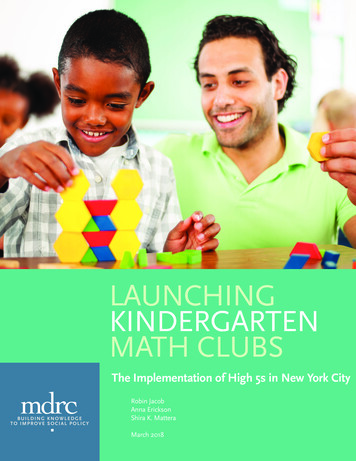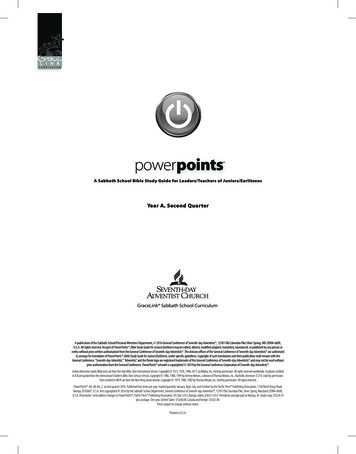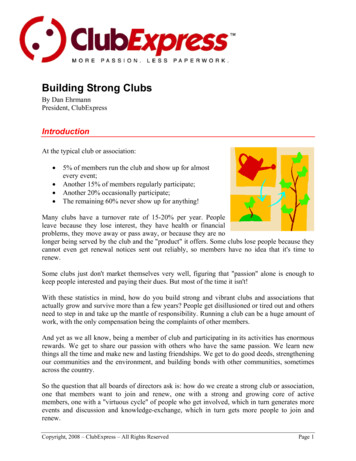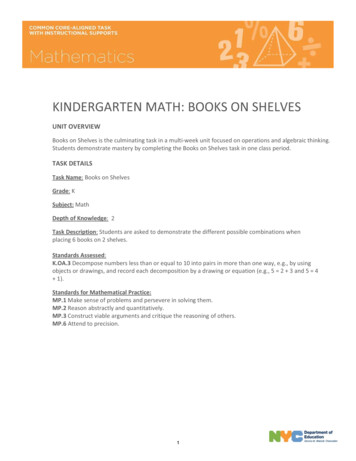
Transcription
LAUNCHINGKINDERGARTENMATH CLUBSThe Implementation of High 5s in New York CityRobin JacobAnna EricksonShira K. MatteraMarch 2018
Launching Kindergarten Math ClubsThe Implementation of High 5s in New York CityRobin JacobAnna EricksonShira K. MatteraMarch 2018
This report is made possible through funding from the Robin Hood Foundation, the HeisingSimons Foundation, the Overdeck Family Foundation, and the Richard W. Goldman FamilyFoundation.Dissemination of MDRC publications is supported by the following funders that help financeMDRC’s public policy outreach and expanding efforts to communicate the results and implications of our work to policymakers, practitioners, and others: The Annie E. Casey Foundation,Charles and Lynn Schusterman Family Foundation, The Edna McConnell Clark Foundation, FordFoundation, The George Gund Foundation, Daniel and Corinne Goldman, The Harry and JeanetteWeinberg Foundation, Inc., The JPB Foundation, The Joyce Foundation, The Kresge Foundation,Laura and John Arnold Foundation, Sandler Foundation, and The Starr Foundation.In addition, earnings from the MDRC Endowment help sustain our dissemination efforts. Contributors to the MDRC Endowment include Alcoa Foundation, The Ambrose Monell Foundation,Anheuser-Busch Foundation, Bristol-Myers Squibb Foundation, Charles Stewart Mott Foundation, Ford Foundation, The George Gund Foundation, The Grable Foundation, The Lizabeth andFrank Newman Charitable Foundation, The New York Times Company Foundation, Jan Nicholson, Paul H. O’Neill Charitable Foundation, John S. Reed, Sandler Foundation, and The StupskiFamily Fund, as well as other individual contributors.The findings and conclusions in this report do not necessarily represent the official positions orpolicies of the funders.For information about MDRC and copies of our publications, see our website: www.mdrc.org.Copyright 2018 by MDRC . All rights reserved.
OverviewEarly math has been shown to predict not only longer-term math achievement, but also futurereading achievement, high school completion, and college attendance. Yet effects from early mathprograms often fade out as children move into more varied instructional contexts in elementaryschool. This fade-out suggests the need for an alignment of math instruction across the early years tosupport children’s earlier math gains.In 2011, the Robin Hood Foundation began a collaboration with MDRC to rigorously test anapproach aimed at boosting early math skills. High 5s, a supplemental small-group math clubprogram for children in kindergarten, was designed specifically as a follow-on to the Making Pre-KCount study, in which preschools implemented an enriched, evidence-based math curriculum(Building Blocks) supported by professional development for teachers. High 5s aligned withBuilding Blocks by focusing on children’s developmental progression, encouraging hands-onlearning, supporting student reflection about mathematical thinking, and using formative assessment(which helps teachers modify their approaches) and instruction differentiated by children’s abilitylevels. As described in more detail in a companion report, children who were offered two years ofenhanced math instruction (High 5s and Making Pre-K Count) had stronger math skills than thosewho had no enhanced math in pre-K or kindergarten — an impact equivalent to more than fourmonths of growth — as well as more positive attitudes toward math. Given these encouragingfindings, this report describes what was needed to implement the High 5s program successfully.Key FindingsWhen the project team set out to design a math enrichment program, there were uncertainties about itsfeasibility: Would schools be receptive? Could an appropriate time and place to hold the clubs beidentified? Would children attend regularly and be engaged? Could enough facilitators be hired at aparaprofessional level salary and retained for an entire year? With the support of a strong training andsupervision model, all these issues were addressed and the High 5s program met all the benchmarksidentified at the outset. Throughout the year, attendance and engagement were high, sessions were heldregularly, and activities were implemented as intended by a team of committed facilitators.All students who were part of the High 5s study also received typical math instruction in theirkindergarten classrooms. Classroom instruction was found to differ in a number of ways from theinstruction in High 5s: Students participating in High 5s were presented with a wider range andsomewhat more advanced instructional content than was observed in classrooms, that content wasdelivered in a small-group format as opposed to the whole-class format in which most classroommathematics was delivered, and facilitators engaged in more open-ended questions and moredifferentiation of material than was observed in classrooms.These findings suggest that small-group enrichment may be one way to provide kindergarteninstruction that is more closely aligned with the pre-K experience, which typically involves asubstantial amount of small-group instruction with many hands-on learning opportunities. The mathclub model may help ensure that children get more individualized instruction, and its alignment withthe preschool experience may be one way to help mitigate fade-out of math gains after preschool.iii
ContentsOverviewList of ExhibitsPrefaceAcknowledgmentsExecutive SummaryiiiviiixxiES-1Chapter1Introduction1222The High 5s Program5577993Staffing the High 5s Program111113154Quality and Fidelity of Implementation171820285Instruction in the Kindergarten Classrooms Compared with High 5s293034386Implications of the Findings41414346Fade-Out of Early Childhood ImpactsThe High 5s Math Club ProgramThe Structure of the High 5s ProgramCommunication with Families and TeachersThe Learning Trajectory FrameworkFormative AssessmentsSummaryTraining and SupervisionSupervision ModelSummaryImplementation DataImplementation FindingsSummaryThe Kindergarten ClassroomsMath Instruction in the Classrooms Compared with High 5s ClubsSummaryPotential Contributions of the High 5s ProgramProgram ReplicabilityConclusionsv
AppendixA High 5s Sample Lesson49B Curriculum Pacing Guide and Sample Activities57C Club Session Log Content71References83Other MDRC Publications on Making Pre-K Count and High 5s85vi
List of ExhibitsTable3.1Facilitator Demographics124.1Amount of Time Spent on Math in High 5s Clubs, Based on Facilitator Logsand Spring Club Observations21Fidelity to the Model: Instructional Quality, Based on Facilitator Logs andClub Observations224.3Student Engagement, Based on Facilitator Logs and Spring Club Observations265.1Description of the Kindergarten Classroom, Based on Classroom Observations315.2Quality of Math Instruction in Kindergarten, Based on ClassroomObservations33Activity Type and Materials Used During Math Instructional Time,Based on Classroom Observations35Nature of Math Instruction in Kindergarten Classrooms and High 5s Clubs,Based on Spring 2016 Observations36Percentage Breakdown of Content During Math Instructional Time inKindergarten Classrooms and High 5s Clubs37Potential Resources Needed to Replicate the High 5s Program During theSchool Day Using School-Based Staff444.25.35.45.56.1Figure2.1Sample Lesson62.2High 5s Counting Trajectory84.1High 5s Club Attendance Rates204.2Facilitators Meeting and Exceeding Expectations of Implementation Quality245.1Instructional Content in Kindergarten Classrooms in Fall 201532vii
PrefaceIn 2011, MDRC entered into a collaboration with the Robin Hood Foundation to identify earlychildhood interventions that had the potential to change the life trajectories of New York Citychildren experiencing poverty. The effort began with a focus on improving early math skills, anarea shown to be among the most important predictors of a young child’s later academicachievement. In a rigorous test, prekindergarten classrooms in New York City were providedwith a high-quality, evidence-based math curriculum (Building Blocks) and ongoing teachertraining and coaching over two years. The program was named Making Pre-K Count.Though few studies of pre-K math curricula follow children over the long term, thosethat do often show a fade-out of math impacts as children move into elementary school. Varioustheories exist as to why fade-out occurs. If shifting educational contexts as children progressfrom preschool through high school are a factor, aligning children’s instructional experiencesacross school years may help maintain pre-K gains. With this in mind, the study team set out toexplore whether a kindergarten enrichment program that was aligned with the pre-K experiencein terms of both content and pedagogy could provide a critical boost that would lead to moresustained long-term achievement gains. That initiative, a small-group math club program forkindergartners called High 5s, which was developed and piloted in 2014 and implemented in2015, is the focus of this report.The project faced a number of uncertainties: Would schools be receptive? Would it bepossible to successfully recruit a team of facilitators to implement the program? Would scheduling and space issues stymie the effort? And if those issues were resolved, would kindergartnerscome regularly and be engaged in a supplemental math club? But the High 5s program met itsimplementation goals. Throughout the year, attendance and engagement were both high,sessions were held on a regular basis, and a team of committed facilitators delivered theactivities as designed. The results show promise: As described in more detail in a companionreport, students who participated in both Making Pre-K Count in pre-K and High 5s in kindergarten had stronger math skills at the end of kindergarten than students who had received noenhanced math instruction, an effect equivalent to more than four months of math learning.This report provides detailed information about the implementation of the High 5s program: what went well, what barriers existed, and the factors that may have contributed to itssuccess.Gordon L. BerlinPresident, MDRCix
AcknowledgmentsThe High 5s program would not have been possible without the collaboration of and fundingfrom the Robin Hood Foundation, as well as funding from the Heising-Simons Foundation, theOverdeck Family Foundation, and the Richard W. Goldman Family Foundation.We appreciate the ongoing support and dedication of the New York City Department ofEducation and the administrators, teachers, and staff of the schools that hosted High 5s clubs.High 5s would not have been possible without the outstanding team at Bank Street College of Education. Katherine Baldwin provided exceptional leadership, direction, and input asthe program director. Erica Buchanan, Nicole Cirino, Danielle Kilcullen, Connie Lafuente, andSacha Lewis worked enthusiastically as supervisors to support and guide the facilitators in theirwork. Elisabeth Adduru and Scott Slavin provided invaluable administrative support. And ofcourse, thank you to the facilitators who made High 5s happen every day with enthusiasm and acommitment to the work.We extend a special thank you to Kristi Hanby at the University of Michigan, whoplayed a lead role in developing and compiling the High 5s curriculum; to Doug Clements andJulie Sarama, who provided ongoing feedback, suggestions, and review of the curriculum; andto Emily Hamlin and Michael O’Keefe, who helped us pilot it.Additionally, we thank Pamela Morris, JoAnn Hsueh, Gordon Berlin, Ginger Knox,Rob Ivry, Marie-Andrée Somers, John Hutchins, Desiree Alderson, and Ali Tufel for theirthoughtful comments on this report and Karin Schneider, Amena Sengal, Samantha Wulfsohn,Shay O’Brien, Rob Mesika, Marissa Strassberger, Nicole Leacock, Adam Greeney, NicolasPlanet, Lyndsay McDonough, Mirjana Pralica, Anne Kou, Mervett Hefyan, Barbara Goldman,Sharon Huang, Dorothy Jordan, Melissa Comerchero, Amy McCampbell, Emily Pressler,Aimee Mun, and Max Snyder for their many contributions to the project. Thanks to JennieKaufman, who ably edited the report, and Carolyn Thomas, who prepared it for publication.Most important, we thank the children, families, teachers, and schools who participatedin the program. Without your commitment and dedication to High 5s, our research would nothave been possible.The Authorsxi
Executive SummaryEarly math is a strong predictor not only of longer-term math achievement, but also of laterreading achievement and even high school completion and college attendance. 1 Thus, boostingchildren’s early math skills is thought to be a way to improve long-term outcomes across a widerange of domains. Working from this notion, MDRC and the Robin Hood Foundation, one ofNew York City’s leading antipoverty organizations, began a joint effort to rigorously testpromising early childhood interventions that might make a lasting difference for childrengrowing up in poverty. The early part of the initiative was focused on trying to boost thatpotential “linchpin” outcome — early math skills.A two-pronged approach to boosting early math skills was planned. The first part,called Making Pre-K Count, provided prekindergarten classrooms in New York City with ahigh-quality math curriculum (Building Blocks) and ongoing teacher training and coaching overtwo years. Building Blocks is a 30-week, evidence-based curriculum designed to take intoaccount and build on children’s natural developmental progression in math skills; it alsoencourages instructional practices such as hands-on learning, student reflection about mathematical thinking, formative assessment to measure student progress and inform teachingdecisions, instruction differentiated by the skill level of individual children, and a mix of smalland whole-group activities.The second part, a math club program called High 5s, is the focus of this report. TheHigh 5s math clubs were designed specifically as a follow-on to the larger Making Pre-K Countstudy and were developed using the learning trajectories research on which the Building Blockscurriculum is based. The program was intended to provide a small-group math enrichmentexperience that was aligned with both the content and approach of the Building Blocks curriculum, for kindergarten students who had experienced Making Pre-K Count in pre-K.The High 5s program was developed by staff members at the University of Michiganwith input from Doug Clements and Julie Sarama, the developers of the Building Blockscurriculum, and was implemented by Bank Street College of Education, which hired, trained,and supervised the club facilitators. The implementation included a number of key components:Greg J. Duncan, Chantelle J. Dowsett, Amy Claessens, Katherine Magnuson, Aletha C. Huston, PamelaKlebanov, Linda S. Pagani, Leon Feinstein, Mimi Engel, and Jeanne Brooks-Gunn, “School Readiness andLater Achievement,” Developmental Psychology 43, no. 6 (2007): 1428-1446; Greg J. Duncan and KatherineMagnuson, “The Nature and Impact of Early Skills, Attention, and Behavior” (paper presentation, Russell SageFoundation Conference on Social Inequality and Educational Outcomes, New York City, 2009).1ES-1
A total of 24 paraprofessional-level facilitators (mostly recent college graduates with limited formal teaching experience) administered the program toover 300 children in 24 New York City public schools during the 2015-2016school year. The clubs typically included four children and one facilitator. Facilitators received substantial training on the curriculum and instructionalapproach before the start of the program as well as weekly coaching and supervision from the Bank Street supervisors and program director that wasdesigned to be responsive to their individual needs. Clubs took place during noninstructional time (before school, after school, orduring lunch). They were designed to meet three times a week for approximately 28 weeks starting in the fall of 2015, with each club session lastingapproximately 30 minutes. Activities in the clubs were designed to move children along key mathematical learning trajectories and were delivered in a game-like format that wasintended to be fun, engaging, and developmentally appropriate.As described in more detail in a companion report, students who had two years of enhanced math instruction (both Making Pre-K Count in pre-K and High 5s in kindergarten) hadstronger math skills (on the REMA-K, 2 one of two measures of math achievement in the study)at the end of kindergarten than students who had received no enhanced math instruction ineither pre-K or kindergarten, an effect equivalent to 4.2 months of additional growth in mathskills. Students in High 5s also had stronger math skills as measured on the REMA-K thanthose who had received only one year of enhanced math instruction as part of the Making Pre-KCount project, an impact equivalent to approximately 2.5 months of growth. 3With these positive findings as a backdrop, this report describes the High 5s program indetail, noting what was needed to implement the program with fidelity to the model. Theprogram set out to achieve a number of goals — it was designed to build on the content of theBuilding Blocks curriculum; to deliver hands-on, engaging instruction in a game-like format;and to provide opportunities for both differentiated instruction and for children to delve deeplyinto mathematical concepts by explaining their mathematical thinking to others. Because theHigh 5s program was new and developed specifically for this project, and because it aimed to2The Research-Based Early Math Assessment–Kindergarten (REMA-K) is a version of the full REMA.For more information on the impact measurement, see Shira K. Mattera, Robin Jacob, and Pamela A. Morris,Strengthening Children’s Math Skills with Enhanced Instruction: The Impacts of Making Pre-K Count andHigh 5s on Kindergarten Outcomes (New York: MDRC, 2018).3Mattera, Jacob, and Morris, Strengthening Children’s Math Skills.ES-2
achieve an ambitious set of logistical and educational objectives, it was not clear at the outsetwhether High 5s could be implemented successfully.Despite these uncertainties, the High 5s program met all the benchmarks identified forthe program at the outset of the study, and with the support of a strong, ongoing training andsupervision model, it was implemented with fidelity. Findings from an analysis of implementation data indicate the following: Student attendance was high, with an average attendance rate of 87 percent across the year. The majority of students attended most of their club sessions, with more than 90 percent of the students having attendance rates over70 percent. Over 80 percent of students had attendance rates over 80 percent. Club sessions were completed as scheduled and the curriculum was delivered as intended. Ninety-two percent of scheduled sessions were completed and club observations indicated that 96 percent of the activities wereimplemented as intended. Students spent an average of 25 minutes in each club on mathematics.The goal was to spend at least 20 minutes of the math club on math. Studentsspent about 75 minutes a week on math in addition to the time they spent onmath in the kindergarten classroom. Facilitators created a positive instructional climate in clubs. All facilitators met expectations for having a good rapport with students. Over 80 percent met expectations for making math learning fun and using positive strategies to manage behavior. This was true even though a number of facilitatorscited managing student behavior as one of the most challenging aspects ofthe job. Student engagement was also high (as reported by both facilitators andobservers). Engagement was rated on a scale of 1 (all students are disengaged) to 5 (all students are engaged). Average facilitator-rated engagementscores were high, with nearly all children engaged in most clubs: Ratingsranged from 4.7 to 4.9 for the different types of High 5s activities. While the program was generally implemented with fidelity to the model,ensuring the highest quality of instruction — instruction that includeddifferentiation, involved reflective questioning, and underscored themathematical objective of the activities — was more challenging, as itwas for the kindergarten teachers in our sample, despite ongoing and highquality training and coaching.ES-3
Overall, the logistics of the program proved to be the most challengingaspect of running the clubs. The most common logistical challenges included finding an appropriate time and place to meet, escorting children toand from clubs, and having facilitators who traveled from school to school.All students who were part of the High 5s study also received typical math instructionin their kindergarten classrooms. To better understand the potential value that the High 5sprogram added, kindergarten classrooms were observed to understand the nature of the mathematics instruction students were receiving and how it compared with the instruction studentswere receiving in High 5s clubs. Instruction in kindergarten classrooms was found to differ in anumber of ways from the instruction in High 5s: The High 5s program presented a wider range and somewhat more advanced instructional content than was observed in kindergarten classrooms. Classroom teachers were, for the most part, following the district’sCommon Core-aligned kindergarten math curriculum, which focused onnumbers and operations for a majority of the year. Geometry, measurement,and patterning activities were included throughout the year in High 5s. Content in the High 5s clubs was delivered in a small-group, hands-onformat, while small-group instruction in the kindergarten classroomtended to be limited. By design, the High 5s clubs were small groups, andall the High 5s activities involved the use of hands-on manipulatives. In thekindergarten classrooms, small-group activities accounted for around 5 percent of the activities observed, and about two-thirds of the activities observedin kindergarten classrooms involved only workbooks or no materials at all. Observations indicated that High 5s facilitators asked more open-endedquestions and engaged in more differentiation of material than was observed in kindergarten classrooms.Overall, despite uncertainty in the planning phases about the viability of a math clubmodel like High 5s, the program was implemented well, with high attendance rates and strongstudent engagement. Staff members with a variety of backgrounds and experiences but limitedformal teaching experience were able to deliver a wide range of math content with adequateinstructional quality. The program had a robust, statistically significant impact on one of twomeasures of math achievement. Findings from this study suggest that small-group enrichment may be oneway to provide kindergarten instruction that is more closely aligned with theES-4
pre-K experience, which typically involves a substantial amount of smallgroup instruction with many hands-on learning opportunities. The small-group experiences that a math club model offers can also help ensure that children get more individualized instruction and do not “fall throughthe cracks.” It is worth considering whether experiences that are more closely alignedwith the preschool experience and that emphasize differentiated instructionmay help mitigate the fade-out often associated with high-quality preschoolexperiences.The positive impacts of the High 5s program demonstrated in this study suggest thatfurther research is needed to examine whether and how it works in different contexts. Forexample, is the program effective in scenarios in which children come into kindergarten with avariety of different pre-K math experiences? Would it be effective if schools used in-house staffmembers to deliver the clubs, or could it be done without the level of training and supervisionthat facilitators were provided in the model that was tested? At the same time, future research isneeded to parse how the different components of the program work and for whom.ES-5
Chapter 1IntroductionIn 2011, MDRC and the Robin Hood Foundation, one of New York City’s leading antipovertyorganizations, entered into a collaboration to identify and rigorously test promising earlychildhood interventions that had the potential to change the life trajectories of New York Citychildren growing up in poverty. The decision was made to focus the initiative on trying to boostearly math skills, which have been shown to be a strong predictor of later achievement foryoung children. 1 Early math skills predict not only later math achievement, but also readingachievement, executive function (the skills underlying self-regulation), and high school completion and college attendance. 2 Math concepts, such as making comparisons, can help expand andenrich vocabulary as children use language to express and justify mathematical thinking. 3 Andearly math is thought to strengthen children’s executive function skills by requiring them tomanipulate numbers and shapes and explain their thinking. 4 Thus, boosting children’s earlymath skills is thought to be a means to improve long-term outcomes across a wide range ofdomains.A two-pronged approach to improving early math skills was planned. The first approach, called Making Pre-K Count, provided prekindergarten classrooms in New York Citywith a high-quality math curriculum (Building Blocks) and ongoing teacher training andcoaching over two years. Building Blocks is a 30-week curriculum designed to take intoaccount and build on children’s natural developmental progression in math skills. 5 Thecurriculum had demonstrated effectiveness in raising children’s early math achievement in anumber of prior randomized trials.6 For the study, 69 sites were randomly assigned either toimplement two years of the curriculum and professional development or to continue theirusual pre-K practices. 7Duncan et al. (2007); Duncan and Magnuson (2009).Duncan et al. (2007); Blair and Razza (2007); Duncan and Magnuson (2009).3Ginsburg, Lee, and Boyd (2008).4Clements, Sarama, and Germeroth (2016).5Clements and Sarama (2013).6Clements and Sarama (2007, 2008); Hofer, Lipsey, Dong, and Farran (2013).7While pre-K sites implemented the program for two years, children in this study entered the classroom inthe second year and received only one year of enriched pre-K math instruction.121
Fade-Out of Early Childhood ImpactsDespite the apparent importance of early math, it is well known that many early childhoodprograms that show evidence of effectiveness at the end of the pre-K year see a fade-out ofeffects as children move out of the preschool setting and into later grades. 8 One hypothesizedexplanation for this fade-out is the lack of alignment between the instructional content andpedagogical approaches in pre-K and the instruction provided in elementary school. 9 Researchsuggests that kindergarten teachers spend a significant amount of instructional time on basicnumber and shape concepts that students already know when entering kindergarten. 10 Preschoolprograms are also often play-based and use a variety of manipulatives, and students frequentlyinteract in small groups with a teacher or other students, while kindergarten classrooms maytake a more didactic approach, with instruction occurring in a whole-group setting or withstudents working individually at their desks. To mitigate the potential fade-out of effects fromearly childhood programming that might result from such misalignment, and to test the benefitof providing an additional year of enhanced math instruction to children, a second initiative wasdesigned.The High 5s Math Club ProgramThe second initiative, a math club program called High 5s, is the focus of this report. The High5s program was designed specifically as a follow-on to the larger Making Pre-K Count studyand was developed using the learning trajectories research on which the Building Blockscurriculum is based. The program was intended to provide a small-group math enrichmentexperience that was aligned with both the content and the approach of Building Blocks forkindergarten students who had experienced Making Pre-K Count in pre-K. The Building Blockscurriculum is designed to focus on children’s developmental progression or learning trajectoriesand also encourages such instructional practices as hands-on learning, student reflection aboutmathematical thinking, formative assessment to measure student progress and allow teachers tomodify their approaches, instruction differentiated by children’s ability levels, and a mix ofsmall- and whole-group activities. 11 High 5s was designed to include these key elements aswell. Some of these practices are more easily implemented in pre-K classrooms than in kindergarten classrooms because of smaller class sizes and smaller teacher-to-student ratios.Hofer, Lipsey, Dong, and Farran (2013); Puma et al. (2012).Lee and Loeb (1995).10Engel, Claessens, and Finch (2013).11Clements and Sarama (2013).892
Before the math club model was selected, a number of different kindergarten interventions were considered. Small-group enrichment was chosen because there is substantial evidence regarding the effectiveness of small-group tutoring for young students in reading and oftwo-on-one tutoring with older students in math. 12 Offering enrichment outside of regularclassroom instruction also provided the study team with maximum flexibility to ensure thatstudents’ pre-K and kindergarten experiences would be well aligned. Since the program was notbeing implemented in classrooms, the study team was able to develop curricular materials andtrain staff independently. The High 5s program paired about four children with one facilitatorfor each club, which met three times a week for approximately 30 minutes, either before or afterschool or during lunch.Making Pre-K Count and High 5s were developed as part of th
Implementation Data 18 . Implementation Findings 20 . Summary 28 . 5 29Instruction in the Kindergarten Classrooms Compared with High 5s . The Kindergarten Classrooms 30 . Math Instruction in the Classrooms Compared with High 5s Clubs 34 . Summary 38 . 6 41Implications of the Findings . Potential










